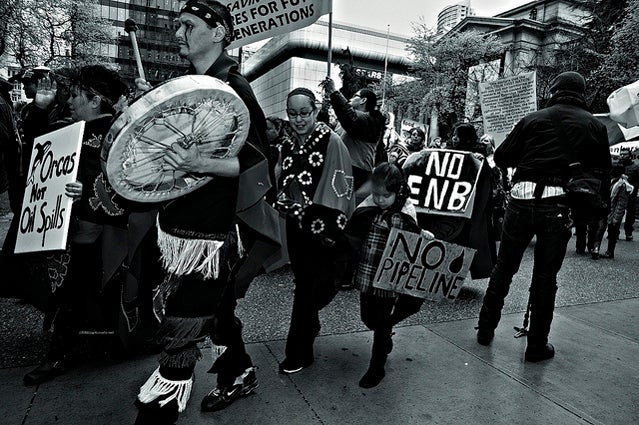
Amid an increasingly conservative Canadian
government focused on exploiting the land’s resources, the country’s indigenous people have risen up through a grassroots
protest movement called .
The Idle No More protest movement was born in late 2012,
started by four activists in Saskatchewan who wanted to garner support to rally
against a wide-ranging bill, C-45, that would remove significant tribal
authority over Canadian waterways by overhauling the country’s 130-year-old Navigable
Waters Protection Act. But the bill passed just before Christmas. Its passage
has only stoked the movement, which is also galvanizing indigenous
groups not only across Canada but those in the U.S. and South America, as well. Demonstrations linked to the movement have sprung up from California to Wisconsin to Maine.
Environmental justice is one of the major themes being
addressed, and in British Columbia, protests are focused on Northern Gateway, a
proposed pipeline that would run 730 miles, traversing the Rockies and
Coast mountain ranges and hundreds of waterways before its terminus in British
Columbia’s Great Bear Rainforest, one of the largest contiguous tracts of
temperate rainforest left in the world.
While the press in the United States has not covered the
protests a great deal, Idle No More is major news in Canada and the movement
gained significant momentum via Twitter (which you’ll see by searching
#idlenomore). Idle No More protests, often taking the form of flash-mob style
drum circles in shopping malls and other public areas, have been attracting
thousands of participants and resulting in civil disobedience arrests.
While the links between Idle No More and the Northern
Gateway protest movement are informal, they’re part of a wider reaction among
indigenous Canadians to an increasingly conservative government, says
Chris Darimont, professor at University of Victoria Geography Department and science director for .
��
“Idle No More is a reassertion of native sovereignty in
our country and also a signal of very deep unrest with the federal government’s
incredibly brazen attempts to demolish environmental protection,” says
Darimont. “Protection for salmon-bearing rivers and lakes is being
unraveled” through legislative efforts such as C-45, he says.
A GROUNDSWELL
Last year the plight of the Great Bear Rainforest and its
people was the focus of a surf documentary co-sponsored by Patagonia and Raincoast Conservation Foundation called Groundswell. I spoke with
filmmaker Chris Malloy about the film after its release and he said one of his main goals was to expose
viewers to the culture and leadership he witnessed among the First Nation
people in the port of Kitimat, where the pipeline would load oil onto tankers.
“Idle No More has become so prominent in indigenous
perspectives and worldviews,” says Darimont. “It really relates back
to the film because the dominant narrative in Groundswell is provided by two
young indigenous leaders. In that respect the film is a little ahead of curve.”
, which has been
playing in surf shops and Patagonia events since the fall, will be available
for download on February 14 .
BLACK GOLD
The decision over whether Canadian pipeline builder Enbridge
will receive the green light falls to a joint review panel
formed by Canada’s National Energy Board, which must make the call by the end
of 2013. The political momentum behind the pipeline is showing cracks, says
Darimont, because the opposition to it throughout British Columbia is so
vociferous—even among the conservative party.
Should the proposal be rejected, however, that won’t change
the fact that Canada is very eager to extract and export its Alberta oil sands
resources. Alternatives to the pipeline include plans for a railroad that would
carry the crude from Alberta to the port in Valdez, Alaska. Yep, that Valdez,
Alaska. The one that leads to Prince William Sound, site of a rather infamous
spill.
Another option would be to build up an existing pipeline,
called Kinder Morgan, which already pipes oil into southern B.C., where it is
loaded onto tankers that transport it past Vancouver and the Puget Sound.
Meanwhile, in Washington, D.C., John Kerry is about to
become the Secretary of State and will need to make a decision over the
northern stretch of the Keystone XL pipeline, which would be a southern
alternative for oil sands crude and which recently gained the support of
Nebraska’s governor thanks to a new route that would keep the pipeline away from
sensitive aquifers.
—Mary Catherine O’Connor